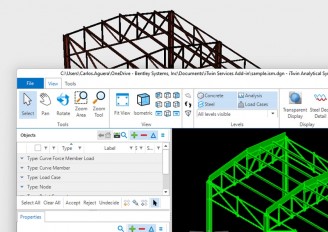Mathematical model for moment-less arch

Researchers from the University of Warwick, inspired by nature's shapes, have introduced a new generation of moment-less arch bridges.
Scientists used form-finding, a process that enables the optimum force flow within a structure, imitating natural forms that are subjected to compressive and tensile forces with no bending moments. According to the research team, this design can sustain any combination of permanent loading without experiencing critical damage and, therefore, the structure can be indestructible.
Wanda Lewis, Professor in the School of Engineering of Warwick University, has been observing naturals shapes for over 25 years and found out that all natural bridges develop simple stress distributions that enables them to sustain greater loads. Prof. Lewis has created mathematical models to apply this principle in man-made structures.
Finding the optimal arch is an issue that troubled scientists for centuries. Back in the 17th century, Robert Hook suggested that the ideal arch shape resembles a catenary (the shape that an idealized hanging chain takes under its own weight when supported only at its ends) while classical theory solution is the shape of inverted parabola. However, those proposals have deficiencies as they do not experience complex stresses under only specific types of loading. The new "form-finding" procedure improves the aforementioned theories by adding a new mathematical model in finding the optimal arch.
The shape that Prof. Lewis suggests can be illustrated using a simple experimental process: A piece of fabric should be suspended, supported only at its tips, and allowed to deform under gravitational forces. Then, the shape should be frozen and inverted producing the intended form shape. Τhe coordinates of the shape are derived by simulating the aforementioned process in computational modeling.
Prof. Lewis stated that even if sophisticated architectural designs are impressive and appealing, they are not capable of distributing the applied forces in the optimal way. "Aesthetics is an important aspect of any design, and we have been programmed to view some shapes, such as circular arches or spherical domes as aesthetic. We often build them regardless of the fact that they generate complex stresses, and are, therefore, structurally inefficient."
Source: Warwick.ac.uk
Want to read more like this story?
Arches
Sep, 14, 2023 | EducationArches, in structural engineering and architecture, form a structural system and have been used in...
Bars (structure)
Sep, 14, 2023 | EducationArches, in structural engineering and architecture, form a structural system and have been used in...

Types of bridges
Jun, 01, 2023 | EducationArch Bridge An arch bridge is a type of bridge that uses a curved, semi-circular structure, kno...

Sea sponges provide insight into how buildings can resist buckling
Feb, 21, 2017 | NewsBrown University engineers Haneesh Kesari and Michael Monn have been studying sea sponges in order t...

SkyCiv Releases Section Analysis Software
Aug, 17, 2022 | NewsThe cloud structural analysis software company SkyCiv this week announced it has added the ability...

New design to make bridge spans longer
Sep, 27, 2018 | NewsLonger bridge spans will be achieved in the future by the utilization of new bridge forms. Resear...

CSiCOL
Dec, 13, 2013 | Software
SAFI Structural Software
Jan, 12, 2018 | Software
Bentley Coffee Corner: STAAD - Creating Custom Steel Sections with the Shape Editor
Sep, 12, 2024 | EventStructural Engineers must consider accurate section properties in the analysis and design of steel...
Trending

Spectacular interchanges around the world

New Release - STAAD.Pro 2024 - 2

ADINA 2025 for Structural WorkSuite

ADINA 2025 New Release!

Concrete Buildings as Rechargeable Batteries

Powerful earthquake shakes central Philippines, dozens killed


